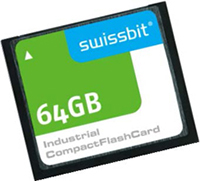By Swissbit 166

Swissbit's CompactFlash® is a small form factor non-volatile memory card which provides high capacity data storage. Its aim is to capture, retain and transport data, audio and images, facilitating the transfer of all types of digital information between a large variety of digital systems. The card operates in three basic modes: PC card ATA I/O mode, PC card ATA memory mode and true IDE mode. The CompactFlash® also supports advanced timing modes. Advanced timing modes are ATA I/O modes that are 100 ns or faster, and ATA memory modes that are 100 ns or 80 ns. Standard cards are shipped as max. UDMA6 (30 ns) and PIO6/MDMA4 (80 ns). If the cards should be used in extended speed modes, they should be qualified on the target system and the system should fulfill the requirements listed below. It conforms to the PCMCIA Card Specification 2.1 when operating in the ATA I/O mode, and in the ATA Memory mode (Personal Computer Memory Card International Association standard, JEIDA in Japan), and to the ATA specification when operating in true IDE Mode.
CompactFlash® Cards can be used with passive adapters in a PC-Card Type I, II, or Type III socket. The Card has an internal intelligent controller which manages interface protocols, data storage and retrieval as well as hardware BCH-code Error Correction Code (ECC), defect handling, diagnostics and clock control. The wear leveling mechanism assures an equal usage of the Flash memory cells to extend the life time. Once the card has been configured by the host, it behaves as a standard ATA (IDE) disk drive. The hardware RS-code ECC allows to detect and correct 6-bits per sector or 24-bits per double sector, depending on the flash. The card has a voltage detector and a powerful power-loss management feature to prevent data corruption after power-down. The specification has been realized and approved by the CompactFlash® Association (CFA). This non-proprietary specification enables users to develop CF products that function correctly and are compatible with future CF design.
| Features | ||
|
|